
Predictive AI for SEO: Tools to Improve Your Marketing Analytics
Predictive AI for SEO: Tools to Improve Your Marketing Analytics
Danny Shepherd, CEO • Intero Digital • September 28, 2023

Predictive AI is not the holy grail for SEO. Like any AI, it’s not without flaw. But when used correctly and intentionally, predictive AI can be an incredible tool for tracking and improving SEO more quickly, easily, and effectively.
In this article, we’ll cover the following:
What Is Predictive AI?
Predictive AI analyzes patterns in historical data to make predictions about the future. Also referred to as predictive analytics, predictive AI determines which — if any — patterns are likely to reemerge so you can make informed, data-driven decisions.
Take a retail business. They might use predictive AI to analyze past customer behaviors and market trends to forecast product demand so they can optimize their inventory and reduce excess stock — all in a matter of seconds.
Automated forecasting. That’s what predictive AI is.
Enabling better, faster business decisions. That’s what predictive AI does.
Improving search analytics. That’s how predictive AI can help SEOs.
In fact, predictive AI can help SEOs even more than the almighty generative AI.
Predictive AI vs. Generative AI
Predictive AI uses existing data to derive future outcomes, while generative AI uses existing data to create entirely new content.
Really, the difference is right there in their names. One predicts. The other generates. One outputs analytics. The other outputs content.
Now that you have an understanding of what predictive AI is, let’s dive into predictive AI’s relationship to SEO.
Predictive AI in SEO
Predictive AI in SEO can help you analyze vast amounts of data — including website traffic, search trends, and user behavior — so you can identify opportunities to improve your website’s rankings and organic traffic. What’s more, predictive AI can process all data, trends, and behavior patterns simultaneously, efficiently, instantly, and in real time.
Allowing businesses to gain insight and make informed decisions faster than ever before is the biggest benefit predictive AI offers SEO.
To illustrate predictive AI’s role in SEO, let’s take a look at nine specific areas where predictive AI can benefit SEO:
- Keyword research: Predictive AI algorithms analyze historical and real-time search data to identify emerging trends and predict future popular keywords
- Content optimization: The AI can analyze a piece of content, identify the intent of the content, find keywords and phrases related to that content that are growing in popularity among search engine users, and then (in a team-up with generative AI) suggest changes to improve the content’s relevance.
- Click-through rate: AI can cross-reference your page titles, meta descriptions, and snippets against those from other sites related to a specific set of queries and predict which of yours are more likely to generate a higher CTR.
- Site architecture and internal linking: AI algorithms can analyze user navigation patterns and provide recommendations for optimizing site structure and internal linking to improve the user experience and SEO.
- Competitive analysis: Competitor analytics are always a bit murky. But predictive AI can more precisely analyze your competitors to provide more reliable insight and forecast potential SEO threats and opportunities.
- Algorithm updates: AI can help predict the potential impact of search engine algorithm updates and recommend strategies to adapt to those changes effectively. So the next time Google releases a core update, you won’t be left scrambling to figure out how to avoid ranking drops.
- Backlink outreach: AI can identify backlinking opportunities, ideal anchor text, and the most effective ways to perform outreach, such as predicting response rates, identifying the best contact methods, and suggesting optimal follow-up timing.
- Featured snippets: With the advent of things like Google’s generative AI capabilities in Search, the already prominent featured snippets will only evolve to hold greater importance. Figuring out how to get a featured snippet has always been tricky. But predictive AI can eliminate some of the guesswork by forecasting which pieces of content have the strongest chance of getting featured.
- Ranking predictions: Predictive analytics models can forecast where your content will rank based on historical performance, algorithm updates, and competitors. So instead of waiting three months to a year to see whether efforts are working, you can find out right away. Imagine the savings in budget and resources.
ChatGPT, Bing AI, and Bard: Which Is Best at Predictive AI?
There are several AI tools out there (many of which are free) that can help you streamline your SEO workflows. But you might be wondering which ones can actually deliver SEO-friendly predictive analytics that you can use right now. So let’s explore a few tools and test them to find out!
ChatGPT
ChatGPT can be a powerful tool when used well, with several use cases in marketing and sales. But can it hold its own when it comes to predictive AI? Let’s put it to the test.
For starters, let’s ask ChatGPT about keyword research.
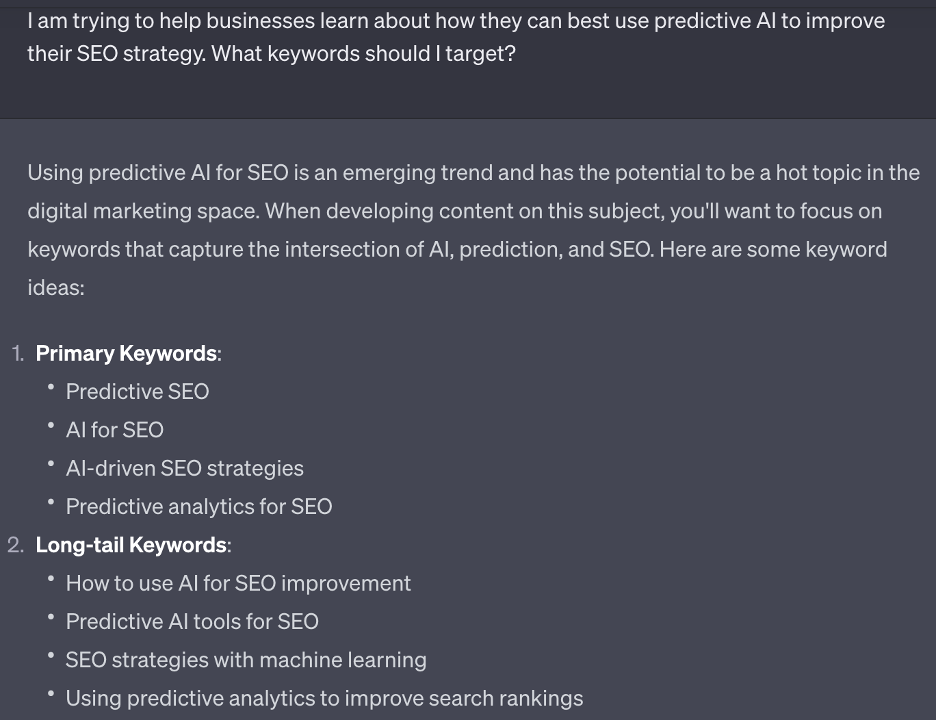
Here’s a snippet of ChatGPT’s response. The chat also included related technical keywords, benefit-focused keywords, tool- or platform-specific keywords, challenges and solutions keywords, case studies and real-life application keywords, educational and how-to keywords, and the following disclaimer:
Remember, SEO is not just about targeting keywords, but also about providing valuable content to your audience. Once you've selected your keywords, it's crucial to craft content that answers the questions and addresses the pain points of your target audience. Incorporate these keywords naturally within your content, meta descriptions, headers, and URLs for maximum effectiveness. Also, always be updated with the latest SEO and AI trends to ensure your content remains relevant and helpful.
— ChatGPT response
Not bad. That’s a decent starting point for keyword research. But it’s not technically predictive analytics. To truly be predictive, the AI needs to provide a forecast. And to provide a forecast, it needs data. So let’s see whether we can get some of that.
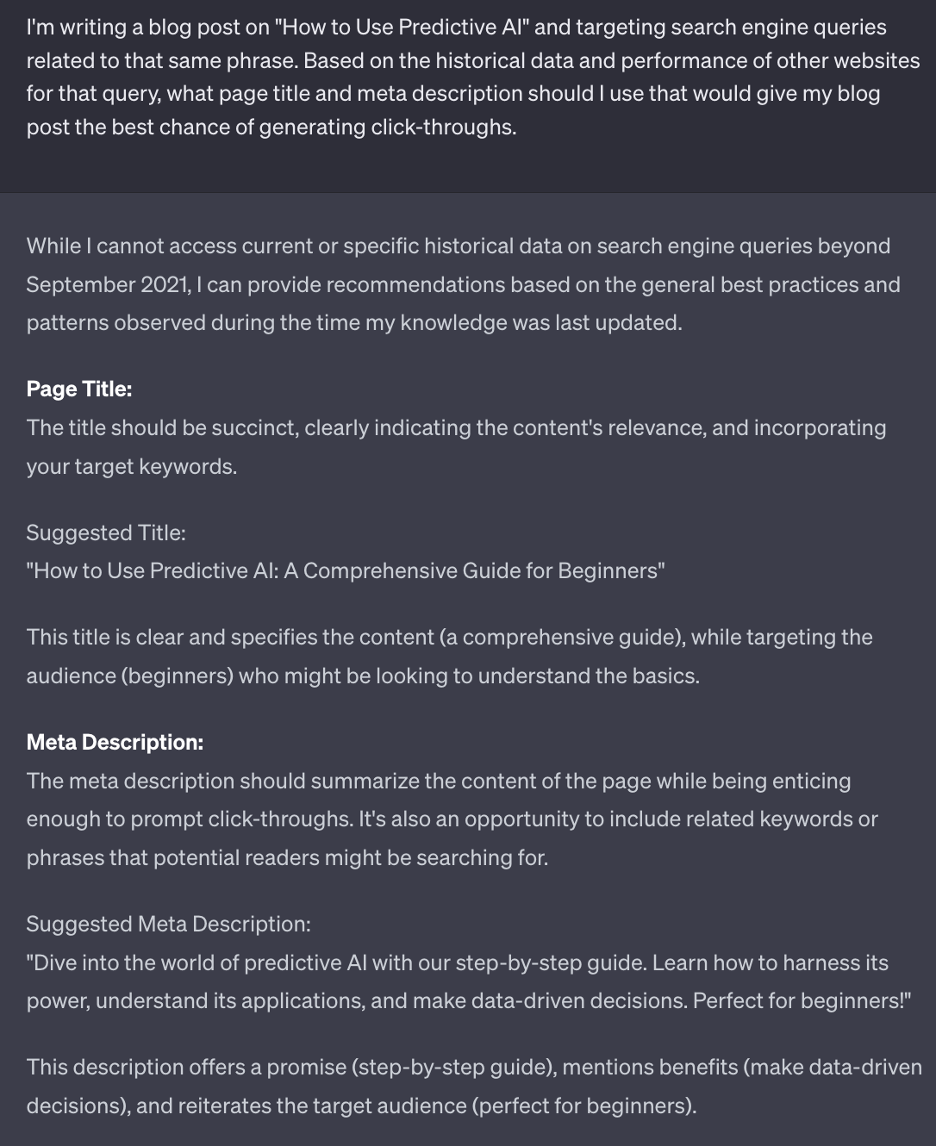
While ChatGPT’s reply answers my query and provides a page title and a meta description based on the topic provided, it does not provide recommendations based on actual data — it provides recommendations based on general best practices. But let’s double-check.
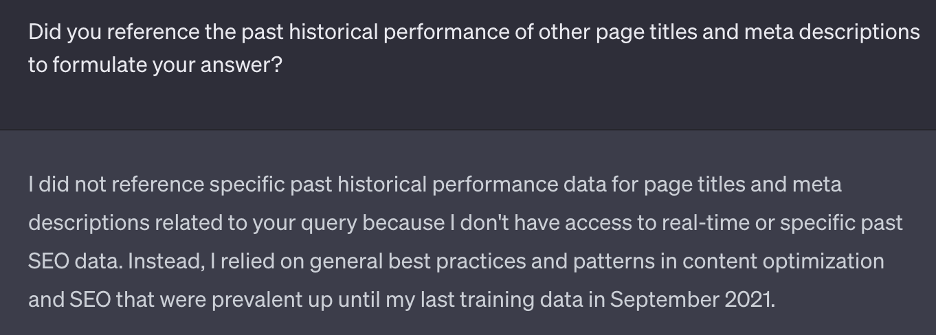
So it sounds like ChatGPT isn’t capable of providing predictive analytics, but let’s triple-check just to be sure.
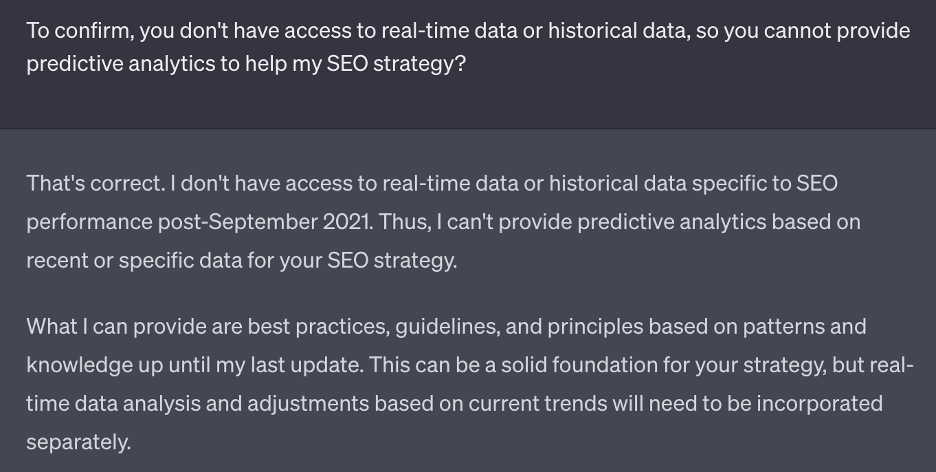
There you have it.
ChatGPT admits that it cannot provide predictive analytics for SEO. ChatGPT would instead fall under the generative AI umbrella. However, with GPT4’s Code Interpretor, you can upload your own data to provide predictive insights. But…and this is a resounding BUT… you do not want to upload any senstive or confidential data to ChatGPT, or it could be used publicly. Once Enterprise rolls out, you should be able upload your data safely and that may just change the predictive analytics game for GPT.
Bing AI
Bing AI is an AI chatbot. Bing had a rough rollout, thanks to its strange and often threatening and morally questionable replies. But Microsoft seems to have addressed those issues. So I think we can safely test whether Bing AI is good at predictive analytics without fear of it breaking up our marriages or gaslighting us.
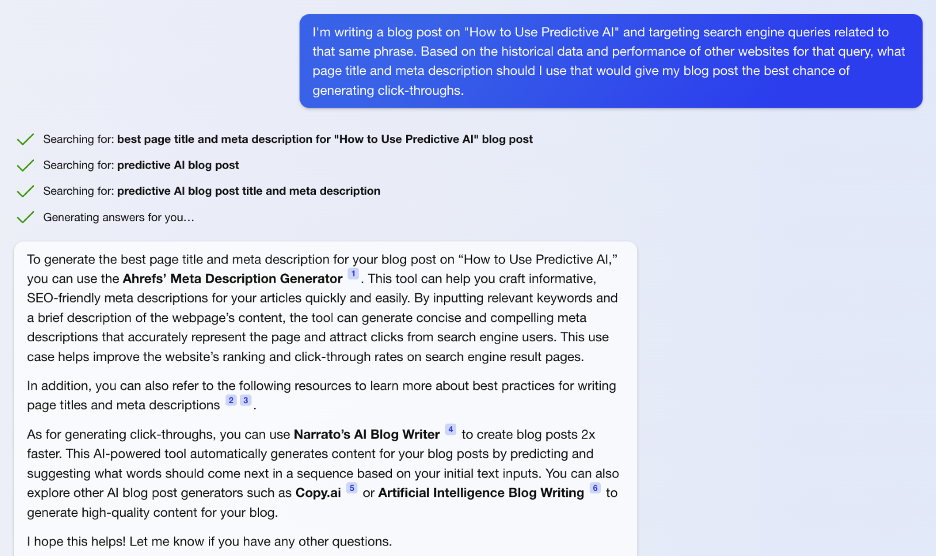
Bing AI’s first response was to tell me to ask someone else. Let’s try again.
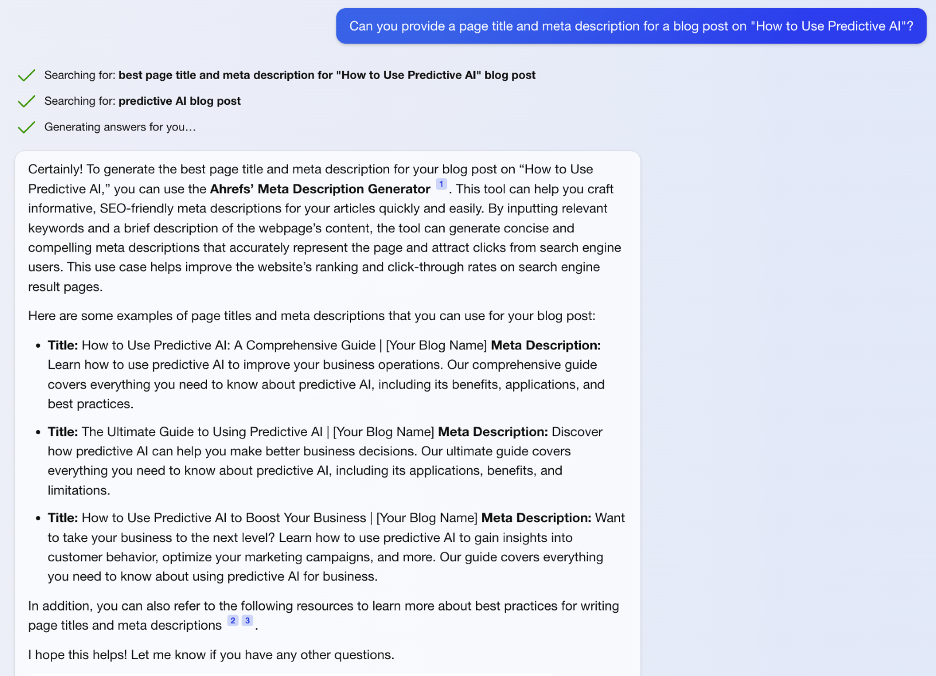
That’s a little better. Now let’s ask whether these page titles and meta descriptions are based on real data.
BingAI's response confirming if it is using past performance to create meta and page titles.

That’s a hard no. So this makes Bing AI a tool that can generate text, but it mostly pulls results from search engine results pages into the chat.
Bard
Third time’s a charm, right?
So far, neither ChatGPT nor Bing AI have hit the mark. Let’s see whether Google’s Bard can do any better.

Not too shabby. But we’ve been burned before, so we’d better be certain that we’re dealing with predictive AI.
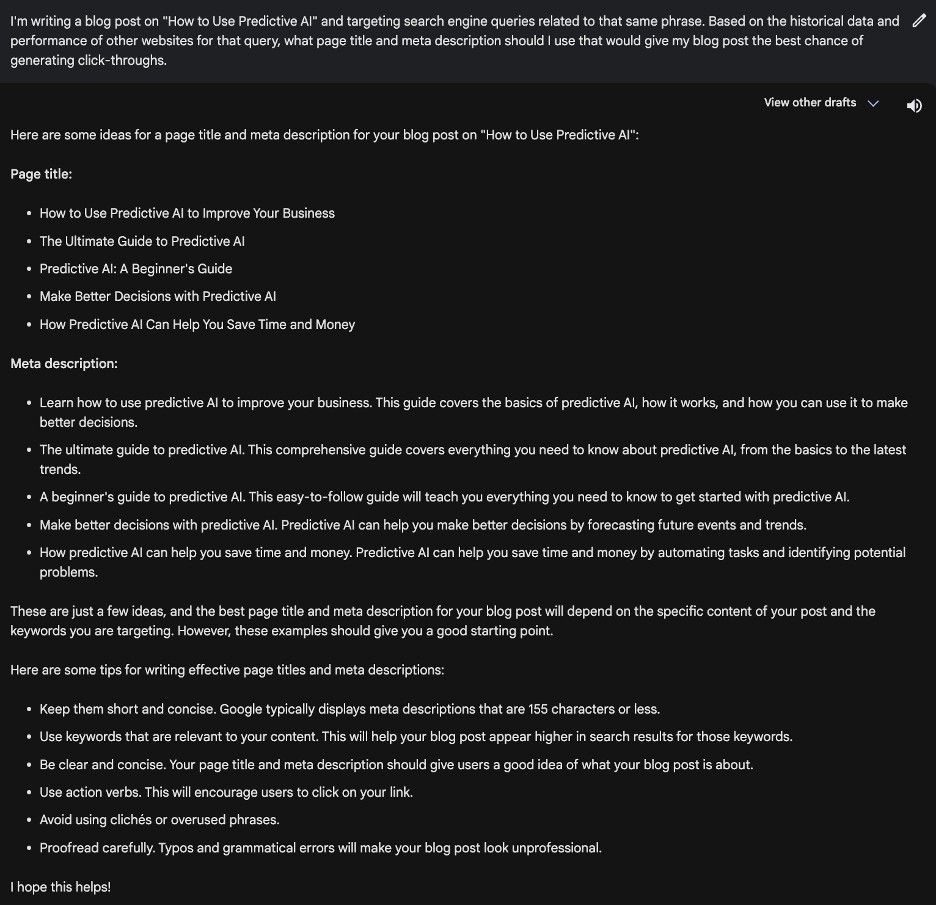
Success! Bard for the win!
When asked, Bard pulls its answers from aggregate data from Google Search Console to forecast how well its suggested answer might perform.
That is predictive AI in action.
Is Bard a Better Predictive AI Tool Than ChatGPT and Bing AI?
Yes.
At least at this time and in this very specific scenario. (AI models are constantly evolving, so who’s to say what each will be able to do in the future?)
Bard beating out the others probably shouldn’t come as a surprise, though, given that Bard has direct ties to the largest search engine on the planet, as well as the most comprehensive SEO tracking tools.
Perhaps Zapier described ChatGPT vs. Bard best:
Bard is built for research, whereas ChatGPT is the better writer.
— Zapier
The GPT in ChatGPT stands for generative pre-training transformer. Bing uses the same generative language model as ChatGPT, while Bard uses the research-heavy PaLM 2 model.
All that is to say…
ChatGPT is great at generating content, and Bing AI shows value as a more efficient search engine, but when you want predictive AI for SEO, go with Bard.
But remember: Just because Bard has proven itself the best chatbot predictive AI in our experiment, that doesn’t necessarily mean it’s always a reliable predictive AI.
Bard is not without issues. Some Google employees have even gone so far as to call it a “pathological liar.” So I recommend pushing back on every output you get from any AI to ensure you’re getting an accurate, factual response.
I really can’t stress that enough.
Are There Other Predictive AI Tools for SEO?
Looking for something different than the tools we’ve tested above? There are several non-chatbot predictive AI tools available, including the following:
Just know that while some of these have applications in SEO, none were built specifically for the purpose. They’re probably more robust than you need, and they can be costly to implement, at least if all you’re looking for is predictive analytics for SEO.
It’s good to know what else is out there, but you have better options for SEO — options that are free and that you’re probably already using.
I’m talking about Google Analytics 4.
If you’re already using it in some capacity, good on you for embracing change. If you haven’t yet adapted, we feel you. (It’s got its issues.)
GA4, like its predecessors, enables you to measure traffic and engagement across websites and apps. What sets GA4 apart are five key services, one of which involves predictive capabilities that offer guidance without complex models.
Those predictive capabilities exist thanks to AI.
Previously, analytics tools used complex models based on cookie-based tracking to provide insights about users and traffic. However, third-party cookies are being phased out. So AI has been incorporated into GA4 to fill the cookie gaps in your analytics data.
This has resulted in two positive things:
- Less work on your end.
- More valuable insights.
A perfect example is GA4’s Analytics Intelligence panel. This can do a couple of amazing things, including:
- Automatically identifying opportunities and offering data-based recommendations.
- Automatically identifying data trends and predicting irregularities.
Both are possible because the AI analyzes real-time and historical data from within your GA4 setup.
In other words, GA4’s AI hits all the marks of predictive AI:
- It accesses real-time data.
- It accesses historical data.
- It looks for patterns in that data.
- It considers how likely it is that that data will reemerge.
- It provides a forecast based on its findings.
These insights allow you to better understand your audience’s behavior and make more informed decisions for organic optimizations. The best part is that you don’t have to do anything to use these insights. GA4 automatically provides them within your dashboard.
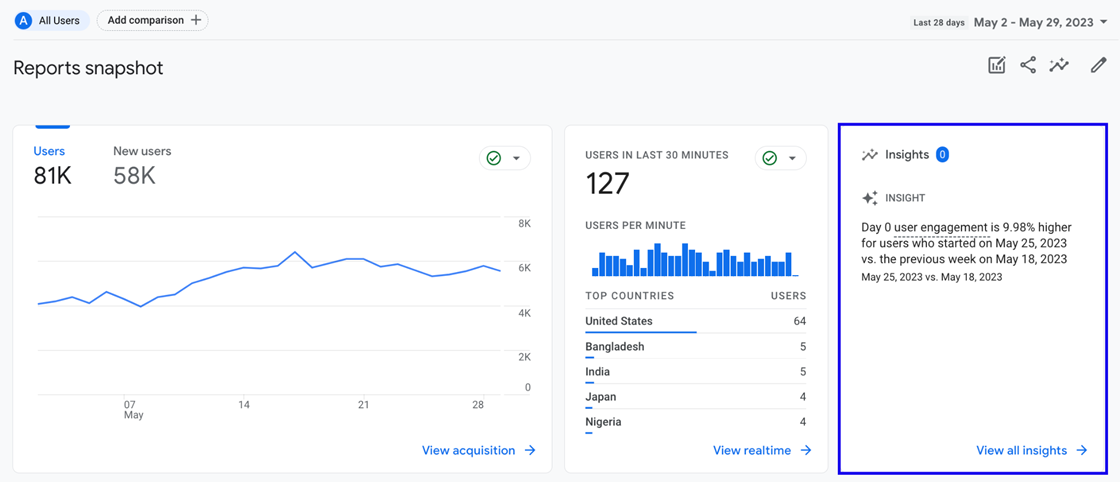
You can also select the “Insights” tab to view them.
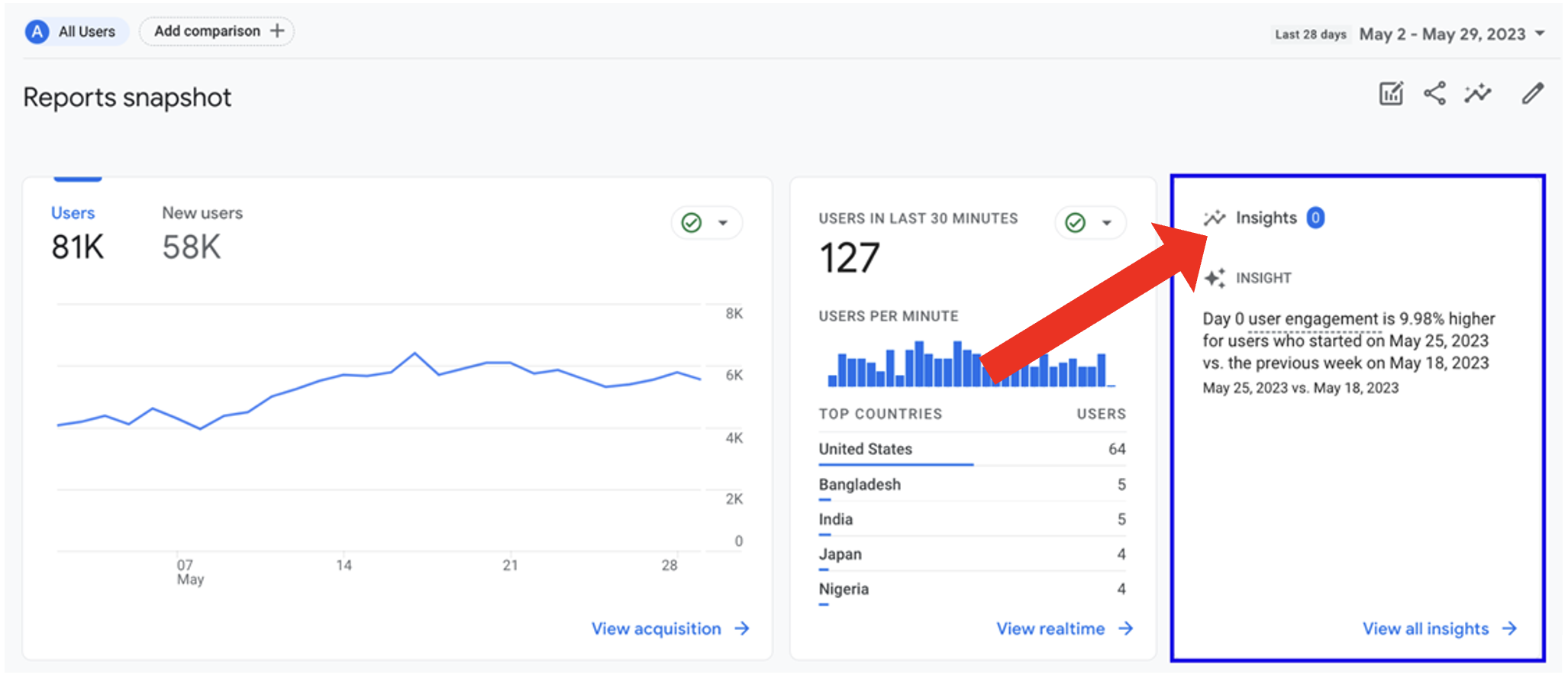
Here’s an example of some organic insights you might receive:
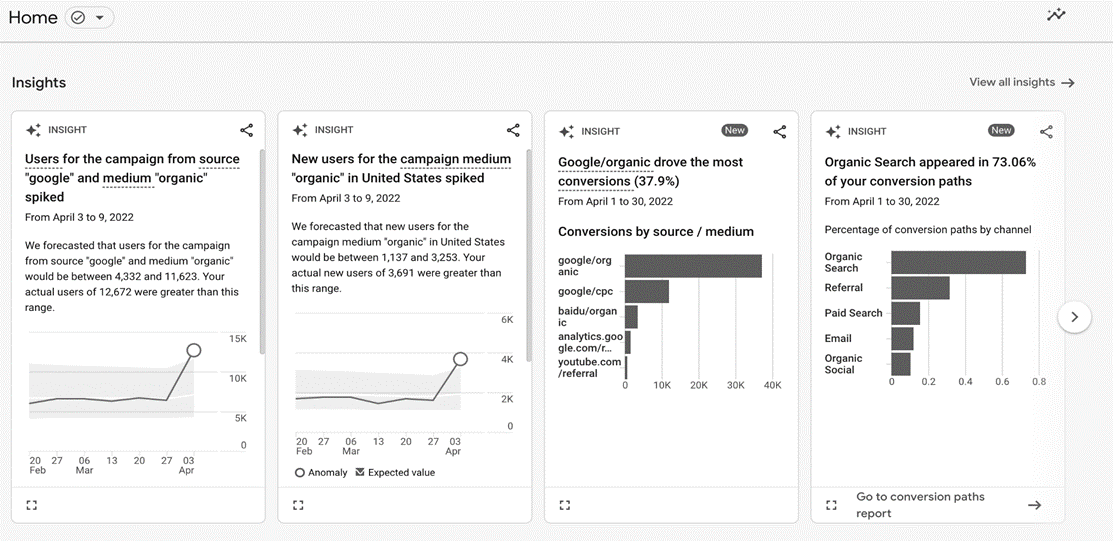
Every time you interact with an insight, the AI will learn which ones you’re most interested in and prioritize showing you the analytics that are most important to you and your business.
If you’d like GA4 to provide insights on a specific metric, you can also create your own custom insight cards that will regularly monitor results and email you when new findings arise.
What Are GA4’s Predictive Metrics?
GA4’s predictive metrics use machine learning algorithms to analyze historical data and predict the future behavior of users, identifying those who are more likely to convert, churn, or generate revenue. This information can be used to improve ad campaigns, the user experience, conversion rate optimization, and — you guessed it — SEO.
GA4 offers three predictive metrics:
- Purchase probability: This metric predicts the likelihood of a user making a purchase within a specified time frame.
- Churn probability: This metric predicts the likelihood of a user churning within a specified time frame.
- Predicted revenue: This metric predicts the amount of revenue a user is likely to generate within a specified time frame.
Here are some examples of how you can use GA4’s predictive metrics for SEO:
- Identify high-value users. Use the purchase probability metric to identify users who are most likely to make a purchase. Then, target these users with SEO campaigns that are designed to attract them to your website.
- Identify high-converting keywords. Use the purchase probability metric to identify keywords worth targeting with your SEO efforts, and predict the likelihood of a user clicking on a search result and converting.
- Identify low-converting pages. Use the churn probability metric to identify webpages that are associated with high churn rates. These pages might be difficult to use or might not meet the needs of users. Then, improve these pages to reduce churn, improve dwell time, and improve SEO performance.
- Identify seasonal trends. Use the predicted revenue metric to identify seasonal trends in your website traffic and revenue. This information can be used to optimize your SEO campaigns around keywords with the best chance of providing the most revenue during specific items of the year.
Before you do all that, though, turn on “modeling contributions and business insights” in your data share settings to ensure you get the best predictive analytics possible.
You will also need to adhere to a few caveats:
- Over a seven-day period in the past 28 days, you need to have at least 1,000 users who triggered a predictive condition (purchase or churn) and 1,000 users who did not generate accurate predictions.
- Only events marked as conversions are eligible for predictive metrics.
- To be eligible for both the purchase probability and predicted revenue metrics, a property has to measure a purchase event and/or in_app_purchase event.
- When you collect the purchase event, you need to also collect the value and currency parameters for that event.
From there, you can begin to use predictive metrics.
You’ll find them in the audience builder when creating predictive audiences and in the explorations section when creating a user lifetime technique.
Any Other Tools I Should Use for Predictive Analytics?
Well, you’ve certainly got options.
A lot of the leading brand-name SEO tools offer some sort of loosely based predictive AI feature or a form of pseudo-predicate analytics.
- Semrush’s Position Tracking provides traffic estimates and insights for keywords based on historical data and search trends.
- Ahrefs’ Rank Tracker is similar to Semrush’s Position Tracking.
- Majestic uses metrics like trust flow and citation flow to estimate the potential future impact of backlinks on a site’s search rankings.
Now, in these cases, the use of “predictive AI” might be a bit of a stretch. But these tools do utilize predictive-inspired elements to inform your SEO strategies, improve your search engine visibility, and analyze data to make forecasts. Not to mention, you can likely expect them to adopt true predictive AI models in the near future.
The Takeaway
As we’ve seen, Google is leading the predictive AI charge thanks to Bard’s ability to access Google Search Console data and GA4’s ability to provide AI insights and predictive metrics. But everyone else will catch up, and new predictive AI tools will hit the market.
But don’t forget: While predictive AI can provide valuable insights, nothing beats human expertise and judgment. Those who take predictions handed out by AI at face value won’t be very successful. Those who interpret, modify, and strategically implement AI predictions for SEO will be.
So what’s the takeaway from all this?
Combining the power of predictive AI with human strategic thinking can lead to highly effective SEO strategies.

 ]
]